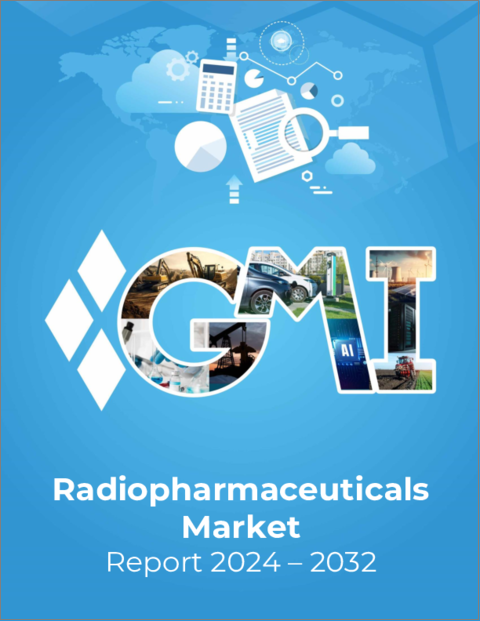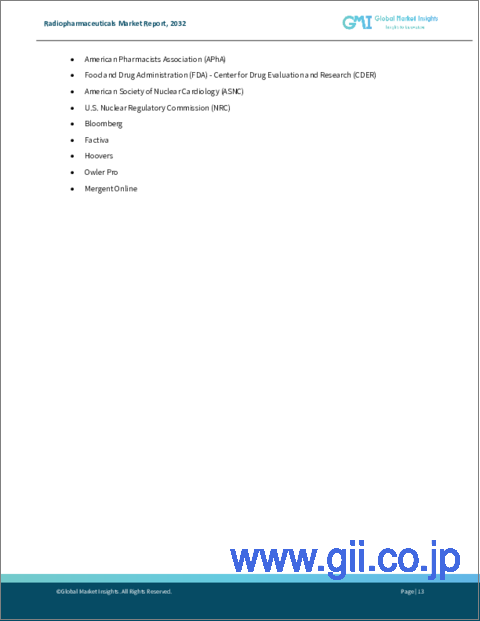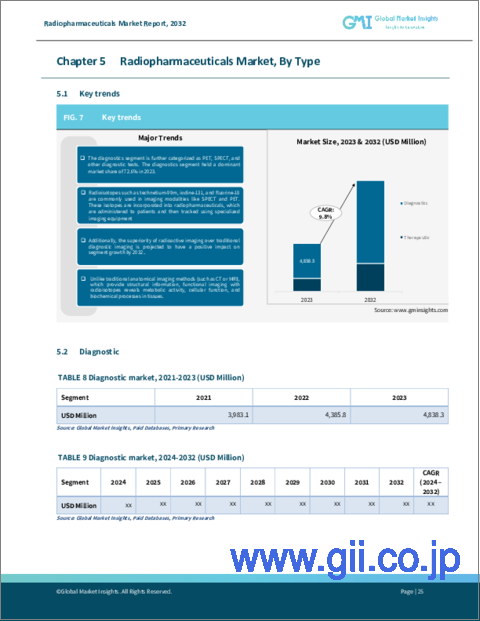|
|
市場調査レポート
商品コード
1572534
放射性医薬品市場、機会、成長促進要因、産業動向分析と予測、2024年~2032年Radiopharmaceuticals Market, Opportunity, Growth Drivers, Industry Trend Analysis and Forecast, 2024-2032 |
||||||
カスタマイズ可能
|
|||||||
| 放射性医薬品市場、機会、成長促進要因、産業動向分析と予測、2024年~2032年 |
|
出版日: 2024年08月22日
発行: Global Market Insights Inc.
ページ情報: 英文 110 Pages
納期: 2~3営業日
|
全表示
- 概要
- 目次
世界の放射性医薬品市場は、2023年に67億米ドルと評価され、予測期間中にCAGR9.8%で成長すると予測されています。
この成長の主な要因は、慢性疾患の有病率の増加、高度な診断ツールや治療に対する需要の高まり、画像診断における継続的な技術進歩です。陽電子放出断層撮影法(PET)や単一光子放出コンピュータ断層撮影法(SPECT)のような主要な画像技術は、従来の解剖学的画像診断法を補完する詳細な機能的・分子的洞察を提供し、診断プロセスの精度を大幅に向上させています。
放射性医薬品の需要は、診断精度を向上させ、がん、心血管疾患、神経疾患などの慢性疾患の早期発見とより良い管理を可能にする能力によってさらに強化されています。その結果、感度と特異性を向上させた放射性トレーサーの市場開拓に注目が集まっており、市場の拡大を支えています。
タイプ別に見ると、市場は治療薬と診断薬に区分され、診断薬が2023年の市場の72.6%を占めています。テクネチウム-99m、ヨウ素-131、フッ素-18などのラジオアイソトープは、SPECTやPETなどの画像診断技術に不可欠であり、さまざまな医療分野の診断手順において極めて重要な役割を担っています。
ラジオアイソトープの中でテクネチウム-99mが最大の市場シェアを占めているのは、その良好な核特性と、複数の診断用途に安定した放射性医薬品を形成する汎用性のためです。このアイソトープが最小限の放射線被曝で高解像度のイメージングを提供できることが、医療用イメージングに広く使用されている主な要因です。
アプリケーションの面では、がんの有病率の増加と革新的な診断・治療法の必要性により、がんの分野が大きな成長を遂げると予想されます。放射性医薬品は、がんの検出と治療にますます使用されるようになっており、この分野が市場成長の主要な促進要因となっています。
市場は線源別にも区分され、サイクロトロンは即時使用のための様々なアイソトープを製造する能力により重要な役割を果たし、放射性医薬品製造の柔軟性と安全性を確保しています。
北米は、高度な診断に対する需要の高まりと、患者の転帰を改善する放射性医薬品の臨床的有効性が実証されたことにより、世界市場をリードしています。この地域は予測期間中に力強い成長が見込まれます。
目次
第1章 調査手法と調査範囲
第2章 エグゼクティブサマリー
第3章 業界洞察
- エコシステム分析
- 業界への影響要因
- 促進要因
- 慢性疾患の増加
- 新規がん治療への投資の増加
- 画像診断の進歩
- 業界の潜在的リスク&課題
- 治療法および診断法の高コスト
- 厳しい政府規制
- 促進要因
- 成長可能性分析
- 償還シナリオ
- 規制状況
- 技術的展望
- ポーター分析
- PESTEL分析
第4章 競合情勢
- イントロダクション
- 企業シェア分析
- 企業マトリックス分析
- 主要市場プレーヤーの競合分析
- 競合のポジショニングマトリックス
- 戦略ダッシュボード
第5章 市場推計・予測:タイプ別、2021年~2032年
- 主要動向
- 治療薬
- 診断薬
- PET
- SPECT検査
- その他の診断検査
第6章 市場推計・予測:ラジオアイソトープ別、2021年~2032年
- 主要動向
- テクネチウム99m
- ガリウム68
- ロジンi
- フッ素18
- 銅64
- ラジウム223
- ジルコニウム89
- その他のラジオアイソトープ
第7章 市場推計・予測:用途別、2021年~2032年
- 主要動向
- がん
- 乳がん
- 前立腺がん
- 肺がん
- その他のがん
- 神経学
- 心臓病学
- その他の用途
第8章 市場推計・予測:供給源別、2021年~2032年
- 主要動向
- サイクロトロン
- 原子炉
第9章 市場推計・予測:最終用途別、2021年~2032年
- 主要動向
- 病院
- 画像診断センター
- 研究・学術機関
第10章 市場推計・予測:地域別、2021年~2032年
- 主要動向
- 北米
- 米国
- カナダ
- 欧州
- ドイツ
- 英国
- フランス
- スペイン
- イタリア
- オランダ
- その他欧州
- アジア太平洋
- 中国
- 日本
- インド
- オーストラリア
- 韓国
- その他アジア太平洋地域
- ラテンアメリカ
- ブラジル
- メキシコ
- アルゼンチン
- その他ラテンアメリカ
- 中東・アフリカ
- 南アフリカ
- サウジアラビア
- アラブ首長国連邦
- その他中東とアフリカ
第11章 企業プロファイル
- Bayer AG
- Bracco
- Cardinal Health Inc.
- Coqui Radiopharmaceuticals Corp
- Curium Pharma
- Eli Lilly and Company
- General Electric Company
- IRE ELiT
- Iso-Tex Diagnostics, Inc
- Jubilant Pharmova Limited
- Lantheus
- Novartis AG
- SHINE Technologies, LLC
- Telix Pharmaceuticals Limited
The Global Radiopharmaceuticals Market was valued at USD 6.7 billion in 2023 and is expected to grow at a compound annual growth rate (CAGR) of 9.8% over the forecast period. This growth is primarily driven by the increasing prevalence of chronic diseases, rising demand for advanced diagnostic tools and treatments, and ongoing technological advancements in diagnostic imaging. Key imaging techniques like Positron Emission Tomography (PET) and Single Photon Emission Computed Tomography (SPECT) have significantly enhanced the accuracy of diagnostic processes, offering detailed functional and molecular insights that complement traditional anatomical imaging methods.
The demand for radiopharmaceuticals is further bolstered by their ability to improve diagnostic accuracy, enabling early detection and better management of chronic conditions such as cancer, cardiovascular diseases, and neurological disorders. As a result, there is a growing focus on developing radiotracers with improved sensitivity and specificity, which supports market expansion.
The overall radiopharmaceuticals industry is segregated based on Type, Radioisotope, Application, Source, End Use, and Region.
By type, the market is segmented into therapeutics and diagnostics, with diagnostics dominating the market at 72.6% in 2023. Radioisotopes such as Technetium-99m, Iodine-131, and Fluorine-18 are essential in imaging techniques like SPECT and PET, making them pivotal for diagnostic procedures across various medical fields.
Among radioisotopes, Technetium-99m holds the largest market share due to its favorable nuclear properties and versatility in forming stable radiopharmaceuticals for multiple diagnostic applications. The ability of this isotope to provide high-resolution imaging with minimal radiation exposure is a key factor contributing to its widespread use in medical imaging.
On the application front, the cancer segment is expected to see significant growth, driven by the increasing prevalence of cancer and the need for innovative diagnostics and therapies. Radiopharmaceuticals are increasingly used in cancer detection and treatment, making this segment a key driver of market growth.
The market is also segmented by source, with cyclotrons playing a crucial role due to their ability to produce various isotopes for immediate use, ensuring flexibility and safety in radiopharmaceutical production.
North America leads the global market, driven by the growing demand for advanced diagnostics and the proven clinical effectiveness of radiopharmaceuticals in improving patient outcomes. This region is expected to see robust growth during the forecast period.
Table of Contents
Chapter 1 Methodology and Scope
- 1.1 Market scope and definitions
- 1.2 Research design
- 1.2.1 Research approach
- 1.2.2 Data collection methods
- 1.3 Base estimates and calculations
- 1.3.1 Base year calculation
- 1.3.2 Key trends for market estimation
- 1.4 Forecast model
- 1.5 Primary research and validation
- 1.5.1 Primary sources
- 1.5.2 Data mining sources
Chapter 2 Executive Summary
- 2.1 Industry 360° synopsis
Chapter 3 Industry Insights
- 3.1 Industry ecosystem analysis
- 3.2 Industry impact forces
- 3.2.1 Growth drivers
- 3.2.1.1 Increasing prevalence of chronic conditions
- 3.2.1.2 Rising investments for novel cancer therapies
- 3.2.1.3 Advancements in diagnostic imaging
- 3.2.2 Industry pitfalls and challenges
- 3.2.2.1 High cost of therapies and diagnostic procedures
- 3.2.2.2 Stringent government regulations
- 3.2.1 Growth drivers
- 3.3 Growth potential analysis
- 3.4 Reimbursement scenario
- 3.5 Regulatory landscape
- 3.6 Technological landscape
- 3.7 Porter's analysis
- 3.8 PESTEL analysis
Chapter 4 Competitive Landscape, 2023
- 4.1 Introduction
- 4.2 Company market share analysis
- 4.3 Company matrix analysis
- 4.4 Competitive analysis of major market players
- 4.5 Competitive positioning matrix
- 4.6 Strategy dashboard
Chapter 5 Market Estimates and Forecast, By Type, 2021 - 2032 ($ Mn)
- 5.1 Key trends
- 5.2 Therapeutic
- 5.3 Diagnostics
- 5.3.1 PET
- 5.3.2 SPECT
- 5.3.3 Other diagnostic tests
Chapter 6 Market Estimates and Forecast, By Radioisotopes, 2021 - 2032 ($ Mn)
- 6.1 Key trends
- 6.2 Technetium 99m
- 6.3 Gallium 68
- 6.4 Lodine I
- 6.5 Fluorine 18
- 6.6 Copper 64
- 6.7 Radium 223
- 6.8 Zirconium 89
- 6.9 Other radioisotopes
Chapter 7 Market Estimates and Forecast, By Application, 2021 - 2032 ($ Mn)
- 7.1 Key trends
- 7.2 Cancer
- 7.2.1 Breast cancer
- 7.2.2 Prostate cancer
- 7.2.3 Lung cancer
- 7.2.4 Other cancer types
- 7.3 Neurology
- 7.4 Cardiology
- 7.5 Other applications
Chapter 8 Market Estimates and Forecast, By Source, 2021 - 2032 ($ Mn)
- 8.1 Key trends
- 8.2 Cyclotron
- 8.3 Nuclear reactors
Chapter 9 Market Estimates and Forecast, By End Use, 2021 - 2032 ($ Mn)
- 9.1 Key trends
- 9.2 Hospitals
- 9.3 Diagnostic imaging centers
- 9.4 Research and academic institutes
Chapter 10 Market Estimates and Forecast, By Region, 2021 - 2032 ($ Mn)
- 10.1 Key trends
- 10.2 North America
- 10.2.1 U.S.
- 10.2.2 Canada
- 10.3 Europe
- 10.3.1 Germany
- 10.3.2 UK
- 10.3.3 France
- 10.3.4 Spain
- 10.3.5 Italy
- 10.3.6 Netherlands
- 10.3.7 Rest of Europe
- 10.4 Asia Pacific
- 10.4.1 China
- 10.4.2 Japan
- 10.4.3 India
- 10.4.4 Australia
- 10.4.5 South Korea
- 10.4.6 Rest of Asia Pacific
- 10.5 Latin America
- 10.5.1 Brazil
- 10.5.2 Mexico
- 10.5.3 Argentina
- 10.5.4 Rest of Latin America
- 10.6 Middle East and Africa
- 10.6.1 South Africa
- 10.6.2 Saudi Arabia
- 10.6.3 UAE
- 10.6.4 Rest of Middle East and Africa
Chapter 11 Company Profiles
- 11.1 Bayer AG
- 11.2 Bracco
- 11.3 Cardinal Health Inc.
- 11.4 Coqui Radiopharmaceuticals Corp
- 11.5 Curium Pharma
- 11.6 Eli Lilly and Company
- 11.7 General Electric Company
- 11.8 IRE ELiT
- 11.9 Iso-Tex Diagnostics, Inc
- 11.10 Jubilant Pharmova Limited
- 11.11 Lantheus
- 11.12 Novartis AG
- 11.13 SHINE Technologies, LLC
- 11.14 Telix Pharmaceuticals Limited





